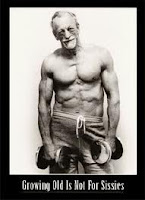More Muscles For Old Chaps, Less Fat for Baby Boomers: The Age Specific Anabolic Anti-Obesity Effect of HMB
HMB - More than expensive leucine for old folks!?
The astonishing results of a recently published study from Jacob M Wilson's lab at the Department of Nutrition, Food and Exercise Sciences at The Florida State University in Tallahassee do yet suggest that at least the best-agers among the SuppVersity students, beta-hydroxy-beta-methl-butyrate could derive undeniable advantages from the almost forgotten leucine metabolite (5% of a normal dietary leucine intake from food sources are metabolized into HMB; cf. Van Koevering et al.1993, according to Wilson. 2012). In what was allegedly "only another rodent study" (before you start complaining, please acknowledge that as long as you don't have your rodents "work out", those studies usually elicit pretty accurate results), the scientists enriched the diets of twelve young (44 wk.), 6 middle-aged (60 wk.), 10 old (86 wk.), and 5 very old (102 wk.) male rats with ~500mg/kg body weight HMB per day, which, using the standard conversion chart (cf. "Ask Dr. Andro: What Are Human Equivalent Doses "), yields a human equivalent of ~81mg/kg or 6.5g for a person who weighs 80kg.
 |
| Figure 1: Changes in body composition (left) and strength (right) during 16-week transition from young to middle age and old to very old age with and without supplementation in male Fisher rats (data adapted from Wilson. 2012) |
HMB shuts down atrophic and ramps up myogenic factors, but why does it burn fat?
The late, but profound increase in lean mass in the very old animals (102wk) was brought about by a totally blunted increase in the "catabolic" Atrogin-1 signaling, the expression of which is so characteristic of aging skeletal muscle, and (and this is actually surprising) an increase of the "anabolic" myogenin expression that yielded myogenin levels which exceed those of the young (44 week) control group by +40%!
Although these changes in Atrogin-1 and myogenin expression can explain the anti-sarcopenic (=working against the age-induced decline in muscle mass) effects of HMB and would even suggest tat it is a very useful "muscle builder" in the elderly population, where similar amounts of leucine (7.5g) have hitherto not yielded not the desired results (Verhoeven. 2009), they do not explain the unquestionably profound effect on the total fat mass of the animals, which reached statistical significance during both, the transition from young to a middle age (HMB body fat change not significant vs. +49% body fat mass in control) and the transition from the old to the very old age (HMB body fat -56%, control -8% n.s.) and of which Wilson et al. say (Wilson. 2012):
To date, the underlying mechanisms that HMB exerts its effects on adipose remain to be elucidated. It may be that HMB directly increases oxidative capacity in myofibers, as exposure of cultured myotubes to the leucine metabolite increased palmitate oxidation by 30%.If the latter, i.e. the increase in palmitate oxidation transfers to human studies, Skelton et al. observed in their in-vitro studies (Skelton. 1994, according to Wilson. 2012), was dose dependent, I would be interested to see studies on the effect of twice the amount of the 3.0g/day HMB per day that did already produce greater increases in lean and decreases in fat mass over the course of a four week resistance training program in a twelve-year-old study in young (Panton. 2000), as well as an eleven-year-old study in 70-year old individuals (Vukovic. 2001), in younger and older trainees, and sedentary individuals.
Something to think about
Also, what if HMB was in fact one of the rare cases, where "more" actually yields "more". I mean, wouldn't it be remotely possible that our body's ability to convert leucine to HMB is not just rate limited, but that the rate decreases with age (this would explain why leucine works much better in younger folks) and saturates, when a certain concentration of HMB is achieved (if that was the case even the 5% conversion could be questionable, because you could have an upper limit of say 500mg, which would be 5% of 10g leucine and just 1% of 50g)? The latter would mean that you could not produce more than x grams of HMB total per day and would imply that the "old natural Deca" could in fact turn out to be superior to the "new natural Deca" for trainees (and maybe even non-trainees) from all age groups - as long as the dosage was appropriate, i.e. beyond what your body would produce from dietary leucine.
References:
- Panton LB, Rathmacher JA, Baier S, Nissen S. Nutritional supplementation of the leucine metabolite beta-hydroxy-beta-methylbutyrate (hmb) during resistance training.Nutrition 2000,16(9):734-739.
- Skelton DA, Greig CA, Davies JM, Young A. Strength, power and related functional ability of healthy people aged 65-89 years. Age Ageing 1994, 23(5):371-377
- Van Koevering M, Gill DR, Smith RA, Owens F, Nissen S, Ball R. Effect of β-hydroxy-β-methyl butyrate on the health and performance of shipping-stressed calves.Oklahoma State Univ Res Rep; 1993, 312-331.
- Vukovich MD, Stubbs NB, Bohlken RM. Body composition in 70-year-old adults responds to dietary beta-hydroxy-beta-methylbutyrate similarly to that of young adults. J Nutr. 2001 Jul;131(7):2049-52.
- Wilson JM, Grant SC, Lee SR, Masad IS, Park YM, Henning PC, Stout JR, Loenneke JP, Arjmandi BH, Panton LB, Kim JS. Beta-hydroxy-beta-methyl-butyrate blunts negative age-related changes in body composition, functionality and myofiber dimensions in rats. J Int Soc Sports Nutr. 2012 Apr 18;9(1):18.



